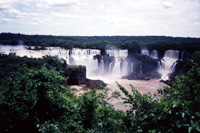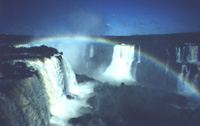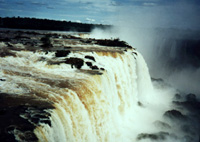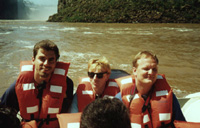 Photo:
Photo: Front cover
from the movie and the original soundtrack from Mission.
This story is taken from the movie Mission (1986), and begins with an amazing
opening scene, which still reminds me about the incredible waterfalls at Iguazu.
In the opening scene you can see a Jesuit priest, tied to a big wood cross by
the Indians, floating his way down the mighty river, and further down the
magnificent falls. The name of the falls comes from the Guarani Indian word
meaning "great water". In 1986 Iguacu Falls were
declared a Natural Heritage of Mankind by UNESCO.
With Ennio Morricone`s music, performed by London Philharmonic Orchestra, in
the background, this scene turns me really on and sends shivers down my spine.
These water walls were the holy graveyard for the Indians for thousand of years
ago, and were discovered in 1541. The falls lie on the border between Argentina
and Brazil surrounded by an breathtaking landscape.
When I arrived here in 1993 I felt it was like an apocalypse to watch the
falls in the entire rainbow's colour. Then it was obvious for me why the opening
song in the movie Mission was called "On the earth as it is in heaven". I
entered the area from the Argentinean side, and moved later on to the Brazilian
side. Both countries have good sites for watching the falls and showering in the
rainy fog from the water.
These great falls are strung out along the rim of a
crescent-shaped cliff over 3km (over 2 miles wide), some 275 individual cascades
and waterfalls plummet up to 80 metres (262 feet) into the gorge below. The
thunderous roaring can be heard from miles away.
Photos below: The majestic Iguazu falls.
 |
 |
I also visited the historic ruins of Jesuit missions from year 1607, which
lie in the area. 100.000 Indians lived in these villages. The majestic Iguazu
falls. I also visited the historic ruins of Jesuit missions from year 1607,
which lie in the area. 100.000 Indians lived in these villages.
The
mission San Ignacio Miní is built in a style of architecture known as 'Guaraní
baroque'. Further up for the falls you can visit a small laboratory
(conservatory), which lie in the jungle and it is preserved by the government.
The Swiss scientist Bertoni did some research on the flora and fauna there, and
he collected a lot of strange things. It is well worth a look too.
Argentinean side
In Argentina Iguazu falls
is located in the Parque Nacional Iguazú near Puerto Iguazú. These falls lie
just east of the confluence of the Iguazu and Paraná rivers.
At least
5000 cubic m (176,570 cu ft) of water per second plunge the 70m (230ft) into the
abyss below. Above the falls, the waters are suitable for canoeing, kayaking and
other water sports. The surrounding park is home to 55,000 hectares (135,850
acres) of pristine subtropical rainforest, with abundant wildlife and plant
species.
Brazilian side
The Rio Iguaçu
arises in the coastal mountains of Paraná and Santa Catarina, the Serra do Mar,
and snakes west for 600km (372mi) before it widens majestically and sweeps
around a magnificent jungle stage, plunging and crashing in tiered falls at the
border with Argentina and Paraguay.
Photos
below. The majestic Iguazu falls. See the beautiful
rainbow! It`s magical!
 |
 |
The
best time of year to see the falls is from August to November, when
there is least risk of floodwaters stopping you from taking a closer look. One
path (walk) you should try, if you dare, is the Devil's Throat.
The sight will hypnotise you, so be
careful - mind your steps!
| Photo: Returning after an exciting boat
trip. |
 |
How close will you go to feel, hear and touch the majestic and roaring
waterfalls? First your hair will rose, so it will be wet. Iguazu Falls is not
the highest falls in the world, maybe the widest, but definitely the most
spectacular falls.
Take a look at the opening scene in the movie
Mission, you will find inspirations too. But I can ensure you, the falls are
more impressing in real.
Stein Morten Lund, 13 July
2000
Additional information
Formal country name:
República
Argentina.
Area: 2.77 million sq km.
Population:
37.81 million.
Capital
City: Buenos
Aires (pop 16 million).
People: 85% European descent,
15% mestizo, Indian and other minorities.
Language:
Spanish; Castilian, Quechua, Guarani, Araucanian, Italian.
Religion: 93% Roman Catholic, 2.5% Protestant, 2% Jewish, 1.5%
Ukranian Catholic, 1% Armenian Orthodox.
Government:
republic.
Formal country name:
República Federativa do Brasil.
Area: 8.51
million sq km.
Population: 170
million.
Capital
City:
Brasília.
People: 55% European descent, 38% mulatto,
6% African descent (according to the 1980 census). In reality, these figures are
skewed by whiteness being equated with social stature in
Brazil.
Language: Portuguese.
Religion: 70% Roman Catholic; also a significant proportion who
either belong to various cults or practice Indian animism.
